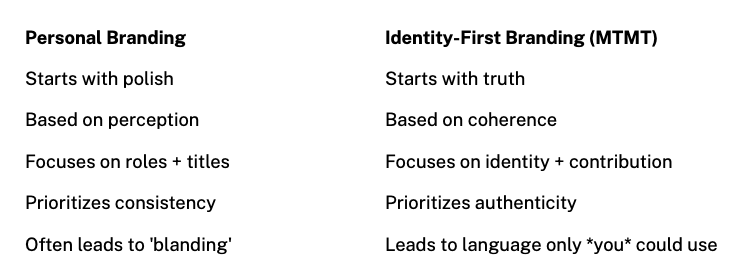Why Personal Branding Fails People Like Us And What Comes Next
TL;DR
Personal branding often fails people with hybrid, nonlinear, or evolving careers. This article explains why identity-first branding—using tools like FBO stories and SKV statements—offers a more authentic, aligned, and effective path forward.
What if I don’t fit into any job title?
Many of my clients ask this exact question. And what they’re really saying is: “I’ve outgrown the language that used to define me.” That’s why we don’t start with job titles—we start with identity.
The Personal Branding Trap
We’ve been sold the idea that a strong personal brand is the key to success. But what if you’ve done all the branding work and it still doesn’t feel like you? That’s a sign you need to start with identity, not polish.
What is identity-first branding?
Identity-first branding is a method of professional development that starts with who you are—your lived experience, values, worldview, and voice—before projecting anything outward. It’s not about image. It’s about coherence. It prioritizes internal alignment before external articulation.
Why does personal branding feel performative?
Because it often is. Personal branding assumes you already know who you are. If you don’t, it becomes a performance that leads to invisibility or burnout. You end up branding a version of yourself that isn’t fully true.
What are FBOs and SKVs?
• FBO (First, Best, Only) story = A personal moment that reveals what you do that no one else can.
• SKV = Seen, Known, Valued statements—phrases that articulate how you want to be seen, known, and valued in your work. SKVs are derived from your Career Belonging Matrix and help you build your professional identity from within.
Personal Branding vs. Identity-First Branding
What Comes After the Breakdown
When people come into my work, they’re often at a threshold moment—post-burnout, post-layoff, or post-caregiving—where they say: “I’ve outgrown how I’ve been seen, and I don’t yet know how to be seen next.” That’s where identity-first branding begins.
Ready to start?
→ Try the MTMT Experience
→ Try Glimmer Career Reflection Companion
→ Read my upcoming book Seen, Known, Valued


